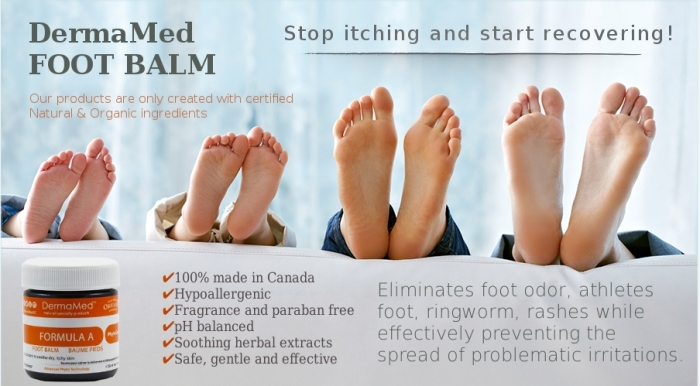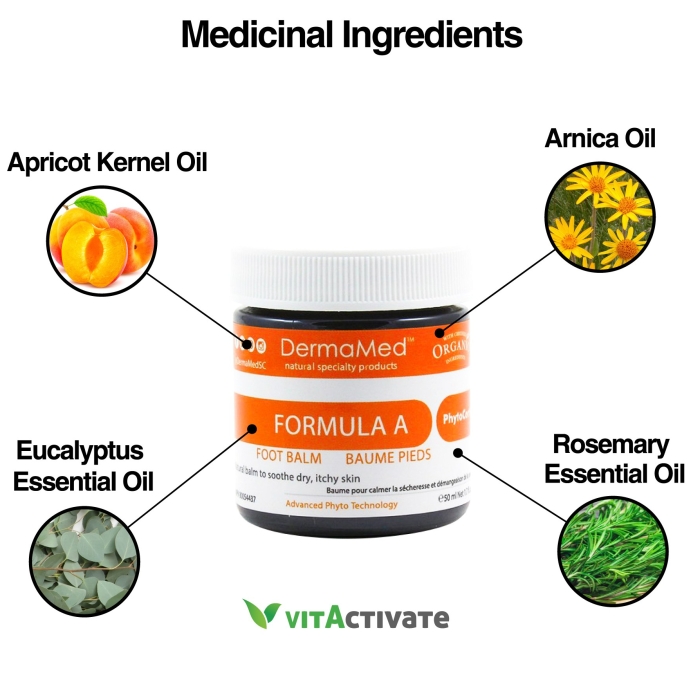Athlete’s foot is a type of skin problem that affects many people. It is caused by a fungus that often develops in between the toes. However, it can also affect other areas of your feet such as the sole or back of the foot.
The fungus thrives on the feet because of the moist environment. However, sometimes people think of it as eczema or psoriasis. This skin condition does not only target athletes but non-athletes as well. Even though it may not pose as a serious condition, a person who develops athlete’s foot will find it uncomfortable and inconvenient.

One of the simplest ways to treat it is to use an organic topical solution such as the DermaMed Formula A Balm. The DermaMed Formula A Balm is an excellent way to provide relief to various skin problems including athlete’s foot, jock itch, ringworm, and other fungal infections. Thanks to its antibacterial and antifungal properties, the DermaMed Formula A Balm can eliminate the infection so that it never comes back.
Common Causes
Technically, a fungus is the main cause of athlete’s foot. It may also be caused by several factors. The most common culprits are sweat, rash, irritants, allergens, psoriasis, toe web infections, tight footwear, and fungal infections.
Another way to spread fungi is by using the socks and shoes of a person who is already infected with athlete’s foot. Since fungi grows in a moist environment, it often thrives on the floors of public areas such as locker rooms, showers, and swimming pools.
Symptoms
An athlete’s foot appears like a dry, scaly, and moist lesion between the toes. It also results in itching and burning. This skin condition is not only limited to the toes as it can also spread in other areas of the body apart from the feet and the hands.
An infection can also result in painful blisters. Once the blisters crack, the exposed tissues lead to swelling.
OTC Treatments
An athlete’s foot can easily be treated with over-the-counter (OTC) medications. It may be in the form of a balm, ointment, cream, spray or powder. Most people with athlete’s foot generally respond well to OTC medications. Plus, it is simple, easy to apply, convenient, and effective.
Most OTC applications take at least one week or more to work. Just make sure you apply it diligently to ensure the success of your treatment. Follow the instructions on the packaging.

An organic balm treatment is perhaps the safest form of OTC medication. While the most common OTC treatments such as topical creams that contain clotrimazole and terbinafine may be popular among people suffering from athlete’s foot, it is not always the best choice. There are other healthier alternatives such as the DermaMed Formula A Balm which contains natural an non-medicinal ingredients such as oils, herbal extracts, and vitamins to treat your skin condition.
In any case, if the topical medication isn’t able to eliminate the infection, you may consult with your doctor. Some skin experts may suggest applying a hydrocortisone cream or oral antifungal medicines.
Complications
Once an athlete’s foot is left untreated, it can develop into a bacterial infection especially when there is a crack in the skin. It can be caused by scratching or when the sores become infected. Hence, once it gets infected, it will require immediate attention.
Remember that athlete’s foot is highly contagious. Scratching the affected area can carry the fungus to other parts of your body specifically your hands and nails. Once it develops under your nails, it may be harder to treat.
When to Visit the Doctor
If your athlete’s foot doesn’t heal or subside after one week of treatment, you should consider setting an appointment with your doctor. You might be advised to take oral medications.
People who are diagnosed with diabetes and have athlete’s foot should also seek a doctor’s advice especially those who suffer from secondary bacterial infection. It can pose more danger and may result in complications.
Those who have diabetes may not feel any pain because of the nerve damage. When you have an infection, the affected area will show signs of redness, swelling, and pus which may be accompanied with fever. Another reason to visit your doctor is when the presence of athlete’s foot starts to interfere with your daily activities.
Treatment and Prevention
OTC topical medications should be applied to the affected and infected portion regularly. Although the treatments may vary, most topical solutions only require an application at least once a day. The amount your rub on should cover the entire affected area. You can apply the treatment once to three times daily.
Taking simple precautions can go a long way. Following proper grooming and being mindful of your environment can help you avoid becoming infected with this skin condition.
Always make sure that your feet are clean and dry. Wearing clean socks made of absorbent material such as cotton can prevent excess moisture on the skin. Once your feet become sweaty, you should change your socks with a fresh new pair.
You can also remove the insoles of your shoes and hang them dry to eliminate the moisture. Others apply talcum or medicated powder inside their socks or shoes to reduce the level of moisture. Another preventive tip is to avoid using the same shoes daily. Let it rest and dry out before using it again.
When you are in public places, always wear slippers to avoid any lingering fungus on the floors of bathrooms and other moist areas. Do not share your footwear with other people. Clean your floors regularly to prevent the growth and spread of fungus.
Before the application a topical medicine, always wash your hands first. Wash it again after application to prevent the spread of the fungal infection to other parts of your body. A clean hand will also prevent it from developing into a bacterial infection.
Most people with athlete’s foot complete their treatment process in a couple of weeks. However, some people tend to deal with it longer and may even last up to a couple of months.


